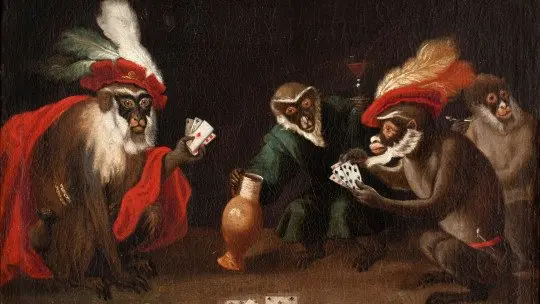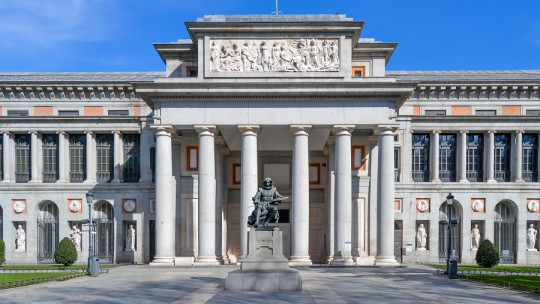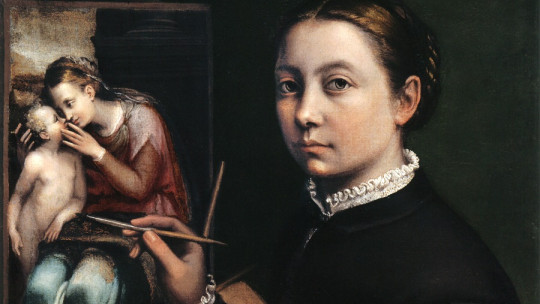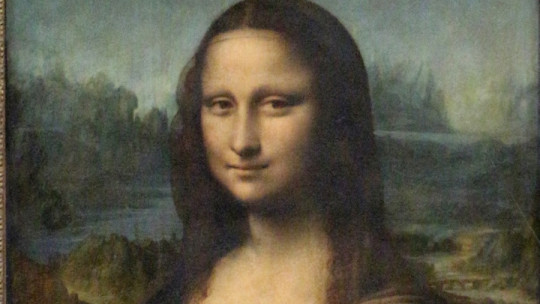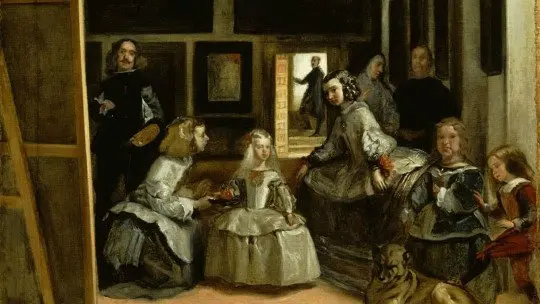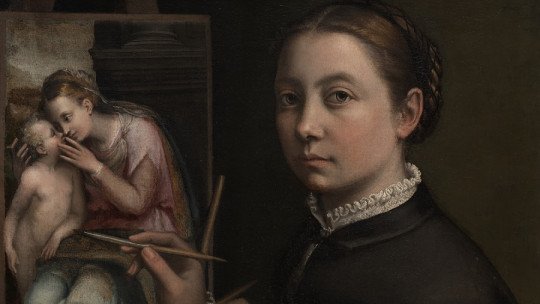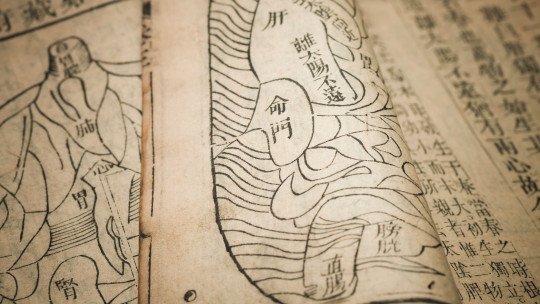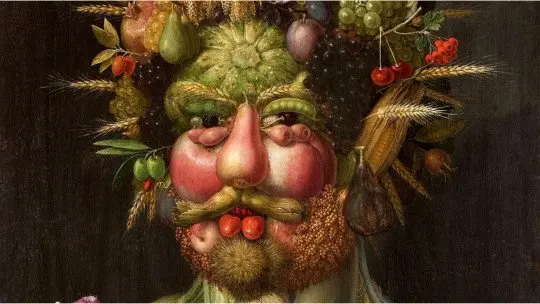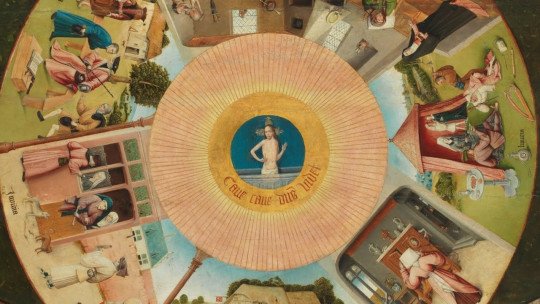
Jheronimus van Aken, better known as Hieronymus Bosch (Bosch in its original language) is one of the best-known painters of the 15th and 16th centuries. But, unlike his Italian contemporaries, Hieronymus Hieronymus has acquired his fame for his disturbing and fascinating, apparently chaotic, language, which captivated personalities of his time. (for example, to King Philip II himself).
What is it about this artist’s works that is so attractive? From our contemporary vision, it may be precisely our distance from the morality that permeates his paintings that draws our attention the most. Indeed; Artists must be placed in their proper context, and Hieronymus Bosch is no exception.
Thus, in his paintings, flamenco exhibits an ideological and moral repertoire closely linked to religion or, rather, to the vision that was had of it in northern Europe at the end of the 15th century. His works emphasize, therefore, sin and salvation, constant models of the men and women of the time.. In today’s article we review how the painter presents sin in one of his most famous works.
The Table of Deadly Sins, by Hieronymus Bosch
The work in question is none other than The Table of Deadly Sins, kept in the Prado Museum in Madrid (Spain) and which was acquired at the time by King Philip II himself, a true lover of the artist.
The table is a table, made of poplar wood (a quite rare material in the artist’s work, who usually used oak), on whose surface the 7 deadly sins and the destiny of the human being after the death are represented in a scrupulous order. death. Let us examine the work more closely and see how Hieronymus Hieronymus represents the theme.
This phrase with terrible resonances for us is inscribed, in its Latin form (cave, cave, Dominus videt), in the center of the table, in the iris of the enormous Eye of God that Hieronymus places as the backbone of everything. In fact, a huge circle similar to an eyeball is the center of the composition, the “Eye of God”, a simile that God is always present and knows all our actions.
To reinforce the message, the artist places in the pupil of this divine eye Christ emerging from the tomb and showing the wounds of martyrdom, thus remembering that Jesus died for the salvation of the souls of the faithful.
The impeccable golden diagonals that start from the pupil and expand across the entire diameter of the eyeball are, in addition to a resource to illuminate the image, a representation of the divine rays that emanate from Christ the Redeemer. In other words: only with Christ is there hope.
The 7 deadly sins according to Hieronymus Hieronymus
Around that “Eye of God” are arranged the 7 deadly sins, which the artist illustrates as everyday scenes so that the viewer better identifies with each of them. In fact, for many experts, Hieronymus Hieronymus was a pioneer in the subject of pictorial customs, which would later have so many followers in Flanders.
1. Anger
Anger is the first sin represented (in the lower center), since, according to Hieronymus Hieronymus’s interpretation, it is the originating sin of many more. Anger thus becomes an unhealthy boil that can unleash a cascade of impious acts (murder, adultery, theft, insults…).
The everyday scene that the artist chooses to illustrate anger is a tavern scene, in which we see two men engaged in a fight that the woman dressed in pink tries to stop in vain. On the floor, we found countless objects scattered on the floor, thrown in the heat of the fight.
Significant is the banner that hangs from the house, in which, if we look closely, we can see a red background (the color of blood and, therefore, passion) with a lion drawn on it, an animal traditionally related to bravery, but also with anger and fury.
2. Pride
Pride is represented by Hieronymus Hieronymus in the form of a small scene smaller than the others, in which a domestic interior is shown. In it, a woman, with her back turned, contemplates herself enchanted in a mirror, which, not by chance, is holding a demon, curiously wearing the veil that women used to wear at the time.. Here, Hieronymus Hieronymus clearly relates the sin of pride to the female gender.
To the left of the scene, at the woman’s feet, we see a chest from which jewels protrude, complementing the lady’s vanity. The still life that the artist captures, so characteristic of Flemish painters, is very notable: above the cabinet, a series of magnificently drawn utensils and, next to the window, a ceramic vase with flowers (again, a symbol of vanity and pride) and a fruit that rests on the windowsill.
3. Lust
For this sin, Bosch chooses an elegant scene, where two couples court each other and “illicit” dealings are required. The fragment is located to the right of the table; In a bucolic and suggestive landscape, a tent is built in which the four characters relax..
On the ground, we see various musical instruments, a symbol of vanity and sin, which the painter also captures in his Garden of Delights. A curious fact is the two jesters who laugh at the lovers and hit each other, as if ridiculing their desire.
4. Laziness
Behind lust is represented laziness, known in the Middle Ages as acidia and closely related to melancholy and depressive states. In the scene, a woman presents a rosary and a prayer book to her companion, as if urging him to pray. However, he remains lazy in his chair and does not seem to have any intention of obeying her.
The domestic interior where this scene takes place is, once again, a delight, and once again shows the talent of Hieronymus and Nordic artists in general for capturing everyday details.
5. Gluttony
In the upper central part the sin of gluttony is illustrated, represented by a family that indulges in a gargantuan banquet without limit or measure. The woman appears in the dining room with a tray full of meat, while the two men drink copiously from their jugs.. The child, represented in a somewhat grotesque manner, also tries to drink from the father’s jug.
The owl that we see sheltered in the niche of the wall is an allusion to sin, since, traditionally, this bird has represented evil and temptation in Christian iconography. In the lower left corner of the scene we see a dog that Hieronymus covered but that, over time, has climbed to the surface of the board. Why did the artist want to remove the dog? We don’t know, but it may have something to do with the symbology of the animal, related to fidelity, although it may simply be a matter of distribution of elements.
6. Greed
The sixth deadly sin, greed, is represented by a sumptuously dressed gentleman (an official, perhaps, or a lawyer) who accepts a bribe. His status as a man of law is reinforced by the open book in the foreground.
7. Envy
Finally, Hieronymus Bosch recreates envy as a couple who desires to obtain possession of their neighbor; in this case, a beautiful falcon that, by the way, the owner displays disdainfully.
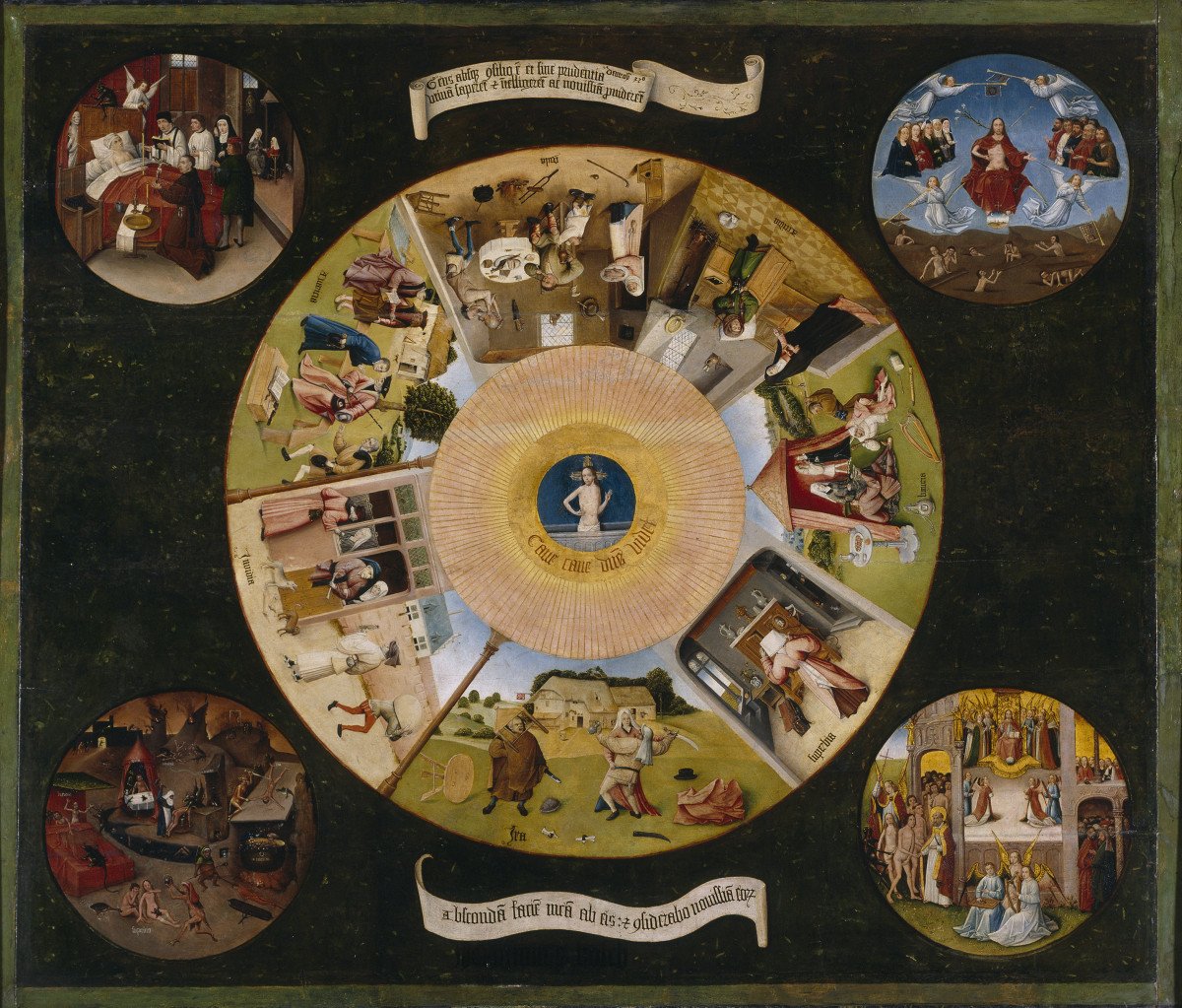
And after death… what?
The iconography of Hieronymus Hieronymus’s table of the 7 deadly sins does not end here. Because, in the four vertices of the painting (as if it were a ludo board) we see 4 more circles; four scenes in which the artist tells us about what will happen to us after death. In the achievement of possibilities (which, in reality, there are only two: Hell or Paradise) we have a lot to do, since, according to the ideology of the time, it is the acts in life that have an impact on postmortem life..
In the first scene (upper left corner), Hieronymus Hieronymus has represented death as the beginning of everything. In the scene we see a dying man who is being given Extreme Unction. Behind, at the head of the bed, a demon and an angel dispute his soul, while Death, anthropomorphically represented by a transide (a living corpse), patiently awaits the result.
In the second scene (upper right corner) we see Christ as Supreme Judge, at whose call the dead rise from their graves. It is the beginning of the Last Judgment, announced by the four angels who sound the trumpets. The roar of his announcement is terrible, since we see how some of the deceased put their hands to their ears, terrified. With this, Hieronymus Bosch wants to convey to us the idea of the terribleness of divine judgment.
In the third scene (bottom left corner), we have one of two postmortem options: Hell. Hieronymus Bosch recreates it as a hell without light, dimly illuminated by a huge fire. In the scene, the demons inflict punishments on the condemned: we see how a species of crocodiles launch themselves to devour a lustful couple who are in bed; to another demon showing a mirror to a woman who is a victim of pride (who has a toad in her genitals), or to a man who drowns in a cauldron full of coins, thus purging his sin of greed.
Finally, in the fourth scene (lower right corner), we can see the option of those who have not committed sins, Paradise. The blessed (the righteous souls), naked as a symbol of purity, are received by Saint Peter, while a choir of angels plays instruments around Christ.. Saint Michael, with the cross raised like a sword, shakes off a demon that is trying to take a woman by the wrist.
Conclusions
Hieronymus Hieronymus’s Table of Deadly Sins is a magnificent summary of the ideology and morality of the time. It clearly expresses how only through good actions can human beings reach Paradise after inevitable death. Thus, eternal damnation remains in the hands of human will, which is free to choose its destiny.
The work functions as a warning that, to us, beings of the 21st century, may seem cruel and dark. However, it was not unusual for wealthy families to have this type of work in their homes. In fact, This panel was acquired by King Philip II of Spain, who held it in such esteem that he kept it in his private chambers..

